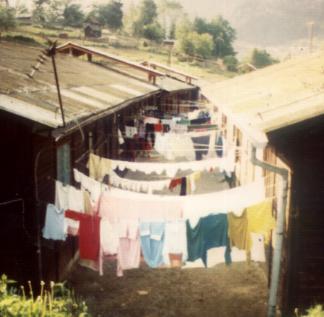DESCRIPTION OF LIFE IN THE REFUGEE CENTRES BY A VOLUNTEER WORKING IN SLOVENIA
Life inside those centres is bleak and monotonous. When one first walked down those corridors, you would see the same expression on every face you met, the same bewildered question - 'how did I end up in a place like this?'
Those long, dark corridors, half-lit tunnels punctuated on either side by the doors which led off into the rooms. Outside each door were the rubbish bins, mostly old food containers, and the rows of shoes belonging to everyone inside. There were electric stoves placed at intervals, there being no spare space to make communal kitchens. These would be steaming with boiling coffepots or pans of vegetables and pouring forth all kinds of smells which would lay heavy in the stale air. Added to this was the odour of damp cloth, for above and in-between all of this there were yards upon yards of clothes lines sagging under the weight of drying washing. And between all this there would be people; perched on stools or metal chairs, people who had come out of their room for a game of cards or just to sit and read a book. Around them others rushed back and forth on their way from one chore to another, or to visit a neighbour's room to drink coffee.
Doors open onto dormitories where twenty odd people would be scattered on army beds or squatting on the floor or windowsills. People in all manner of positions; from the elderly to the newborn, the healthy to the dying, a whole mass of humanity stuffed into one place. A riot of colour and pattern, texture and smell, talking and laughing and coughing and sighing. And then there are the family rooms which are decorated with children's drawings or old photo's of their hometown. Despite the overcrowding and the squalor this is the closest thing to home these people have. On sunny days people move their chairs and tables outside and some sense of community is achieved. As the days of thier temporary stay have drifted into months and years, so little pieces of 'civilisation' have been added. An old sofa would be found, a charity would donate a record player or television, and a communal sitting room or 'club' would be formed.
And every day these people woke up to the faces of strangers; washed, ate and defecated among people unfamiliar to them. Doctors, lawyers, farmers, lorry drivers, the honest and the dishonest, the cowards and the heroes, the hopeful and the hopeless. Nobody could hide a secret, nobody could conceal an illness; they were condemned to one another day after day. In a corridor of 45 people, in a building of 200, there wasn't a moment of the day or night when there wasn't the shuffle of feet, the whisper of conversation, coughs, snores, laughs, inhalations and exhalations. Not one individual could escape the gaze of the collective - he was continually under scrutiny. Only for those lucky enough to be placed in the towns was there escape to the anonymity of the streets, of the market place, of the crowd, was there any relief from that gaze. But most of the refugee centres were to be found on the edges of the towns, on the outskirts of 'civilisation', miles away form any sense of the outside world or of any other reality other than those long, long, crowded corridors.

Back to Main Page
|
